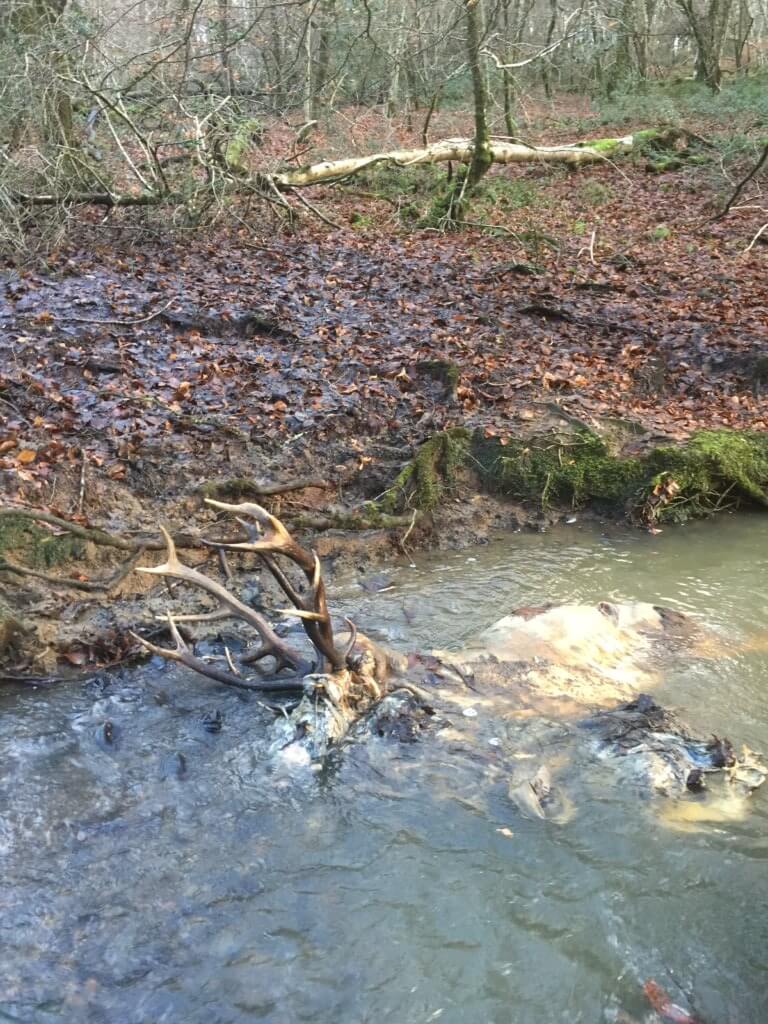
It’s taking a bit of liberty including this image under the wild food banner, but the Red Deer certainly qualifies as a species that can be eaten. Indeed, some would argue that along with other wild deer it is one of the most sustainable forms of meat available here in Britain, albeit one that is not readily available in the supermarkets. But that’s for another day.
I came across this sight (and smell) on New Year’s Day this year a few miles from the house. At first I took it at face value – the poignant image of a large Red Deer stag that had seen its last rut and was gradually decaying into a woodland stream, swollen by recent rains. Then I looked more closely and realised that all was not as it seemed. It was two stags, not one. If you look closely there are four antlers and two of them (one from each stag) are locked firmly together.
More slowly than I’m keen to admit, it dawned on me what must have happened. These were rutting stags that had been fighting and were simply unable to free themselves once the antlers had become interlocked. Whether one died quickly during the fight leaving the other animal unable to break free – or whether both simply became exhausted as they struggled and failed to detach themselves, it’s impossible to say. Either way, ending up in a fast-flowing stream can’t have helped. It was a sombre reminder that wild animals have a pretty hard time of it out there, even without unwanted human interventions. It was also a reminder that most of this hardship goes unseen. These animals had died in full view, out in the open, only because of a most unusual set of circumstances.
[registration_form]
The meat of various deer species, should be more widely available to the general public.
This would help underpin the ever increasing need for management, for the protection of habitats,and the deer themselves. If ‘Lidl’ can market Reindeer steaks in the run up to Christmas, I am sure others would find this market profitable.
Some of the smaller deer species are superior in flavour to red, however the latter is excellent slowly roasted.
Ian, I don’t suppose you had a good knife handy?, they would have made an interesting display once cleaned.
Whilst reading this, appearing among the adverts on the right of the page, is a firm offering Deer stalking courses to attain Dsc (level 2), how the hell do they know ?, frightening.
Interesting photo Ian, have never come across two locked together before myself, but have found Red with all sorts in their antlers. One I remember had tangled itself in a large mass of flexinet electric fencing that hung about the top of it’s head like a bizarre crown of thorns, it had cast one set of antlers, which remained dangling in the netting and had grown a new set the following year, before the load and the sores caused by the rubbing had taken their toll sufficiently to weaken the animal. Another one, that was perhaps the most bizarre thing I have seen involving deer, was a Red that somehow managed to get one of its antlers caught up in an orange plastic chair – the sort you get in village halls, metal legs with a one piece moulded plastic seat with an oval cut out of the back – the chair was perfectly upright in the air as the animal ran through the woods. Not sure what happened to the stag, he appeared healthy and the legs weren’t touching him to rub at the skin. It was in Devon, so if you ever come across a faded plastic chair with an antler through it, you’ll know why!
As for wild food and deer, Roe win everytime!